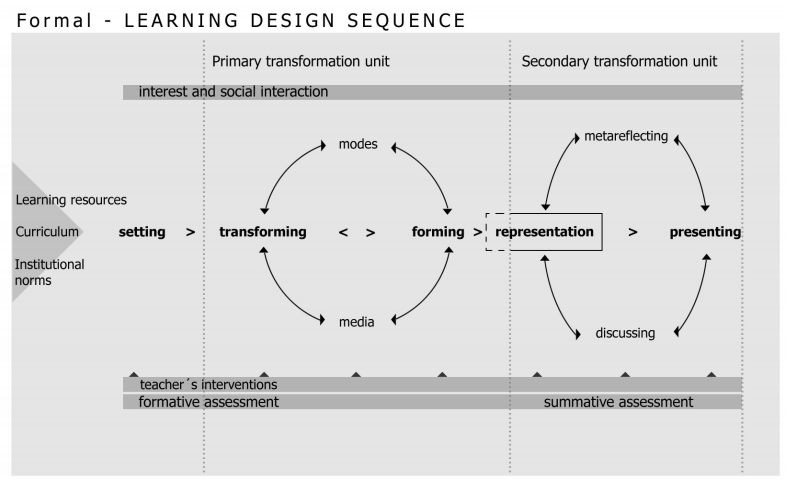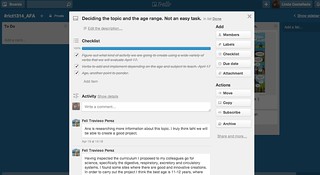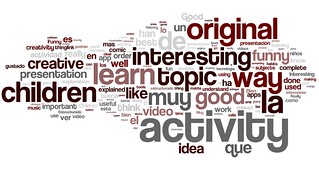I was writing a long intro to this post, but it is not important. This is just for sharing with you the reflections of one of the groups of my students (students of 1st year of the degree in Primary Education Teaching) about the Dark side of TextBooks, as the final part of a task in my class.
The Dark Side of TextBooks
By Friskihedgehogs
Government and editorials
WE ARE GOING TO START FROM THE END: the relationship between government and editorials and their interests to make money thanks to the educational system (Adell 2010). This situation goes on to a worse and deeper problem, the consciousness of teachers as professionals. The teacher’s creativity melts in a useless tool in which they do not consider themselves like key pieces of the educational process, they rely on the textbook with so fiercely that they have lost the point of teaching. Therefore, the entire planning and lessons are driven throughout the daily class, semester and year with the only contents into the textbook. Besides, the content of the textbooks is something that does not escape from the evil hand of the bias.
Raymond Williams in W. Apple (2000) argues that books are created for people who have a specific knowledge, culture, vision and ideas. If we assume that, we must be aware that the bias and pressure that governments pose over the editorials is overwhelming. Many times, the money editorials make is by linking their products with the ideological purpose of politics. Thus, the benefit of the book sales goes directly to the pockets of those who have the control over the educational system and the editorials. By managing the educational curriculum with that power relationship they decide what materials are used, what teachers must do and what textbooks they must follow. All in all, it is a way to manage the knowledge and the knowledge is power, and the roads from where the knowledge travels are part of the social distribution of power, as it is said by John Fiske in Apple (2000).
Moreover, the next sentence is perfect to grasp the idea “education and power are terms of an indissoluble couplet” (Apple, 2000). This means going so far away, but we want to let this as crystal clear. The neo-Marxist ideas in the sociology of education saw how the official knowledge was distributed and, who controlled its distribution. Therefore, schools act as factories in which the dominant class position is teaching its ideology so as to maintain and legitimatize its social position, Althusser in (J. Saha, 2011).This relevant statement falls dawn on how knowledge is collected into the textbooks and as said before, it is written for someone with an ideology and with a specific intention, perhaps is so rude but, do we need, under such evidence, believe and rely on textbooks to guide our daily lives as teachers? Can we keep going with this textbook in our classroom? Is it not enough all that we know?
The most important fact for me is boys and girls in class, their future as citizens of a society, a society asking them to be competent, but competent under the current society peculiar interest. If we accept the textbook a unique guide, no one is teaching them to be critical, free, dreamers or happy, we are teaching just the contents or even worse, the packet knowledge in a textbook. We will teach them their social class and make them understand where their limits are. Here is the word, “limits”. Whereas, if we teach them where the dominant class is, how they act and how they control society. We will teach them how to be critical boys and girls who will hit this world, we will teach them how to think away from the ideological bias of the textbooks and, of course, make them able to think out of the box.
All in all, we will not set any “limit”, yet we will teach them how to take off to bit this planet. At this point, we consider tackling an important issue, as textbooks are used to deliver the so-called “official knowledge” (Apple, 2000). What are students really learning when an entire class is tied to a textbook? Can we assume that everything stated in a textbook is learned by them? Or even worse, can we assume each teacher teaches exactly what is in a textbook? Without a doubt, every student has a background, cultural basis, religious, families and an SES which differ from another; otherwise, we do not have our lovely diversity. Besides, we cannot assume the students are blank sheets eager to be painted with an amount of information, information that is supposed to be the body of knowledge with which they can obtain the Promised Land. They are not passively reading the book or learning from it, they have their own thinking and beliefs (Apple, 2000).
ONE OF THE MOST STRIKING FEATURES OF THIS TOPIC IS; what is it inside of a textbook? How is the information distorted? And, how are political interests in? “Textbooks introduce young people to an existing cultural and socio-economic order with its relations of power and domination” (Crawford, ND). Crawford states in his research about textbooks analysis an evidence of how many textbooks around the world contain bias depending on the political interest, for instance, in Spain they found evidence on how editorials have to provide the history of a region in 8 different forms in a textbook by Makay (1997) in (Crawford, ND). There is an European organization, The Georg Eckert Institute for International Textbook Research in German which is in charge to analyse, compare and identified, historical, political and geographical presentations in the textbook (Crawford, ND). Knowing about the existence of this institution is ok; however, it does not solve the real issue, the manipulation of textbooks distribution and contents under political interests. Thus, what could we do as a teacher? Of course, the answer is far to be easy, because we cannot change the whole system but, by knowing what politics and editorials do, we can manage the planning and the classroom and go deeper or not in a topic if we use our critical thinking about the textbook.
At this point, we want to state that critical thinking will help us to engage our students to be critical as well, and as a result, either teachers or students can start a flame which can be the first step to change the entire educational system. Because knowledge it has not to be in a textbook, knowledge is surrounding us, it is anywhere, in different forms, knowledge is drifting among us in our daily lives, knowledge is free and it is the seed of other knowledge. Knowledge is delivered and shared with our friends, parents, teachers, museums, cinemas, pictures, drawings, etc. Knowledge is alive, and it has no limits, no boundaries. This statement drives us directly to the controversy in our country, Spain, in which editorials are trying not to lose money with ridiculous arguments while sinking in a lake of reality. They blame the government for encouraging schools for hacking; they state the schools are spending money on devices with no content; and, something funny, they argue that there are no evidence that ICTs are good at all (Adell , 2010).
The fear of losing privileges and money is evident. It is like a tantrum of a kid because there is no chocolate left to eat. They are not aware of that knowledge is free. As Adell (2010) claim, the content textbooks, the inadequate web support offered by editorials and, libraries full of books are nothing without the teachers’ work because the content does not teach by itself. Also, there are several groups of teachers sharing planning, methodologies, and documents completely free which give us the opportunity to take the planning from other schools (Adell , 2010).
It does not surprise us that editorials become mad in front of such evidence. But the idea is brilliant. We can share everything just with a click. The good news is that we will have the opportunity to develop our method or planning in a group and when we say “in group” we mean the entire earth. Thanks, the internet we can chat with any teacher or headmaster of any school wherever. The amount of experience, knowledge and wisdom are tremendous. Besides, we can compare with others what they did and what they tried, just to avoid mistakes committed before. The real benefit is that knowledge will be growing nonstop with no limit.
The textbook and some limitations
WE DO NOT WANT TO GO SO FAR AWAY FROM THE REAL ISSUE, but the theory of multiple intelligences argues that each individual has a number of specific abilities (J.W., 2011). As teachers, we must provide the best path for our students for powered their abilities and spark their motivation to learn and to learn how to learn. Howard Gardner (2002) stated that every human being has eight kinds of intelligence, verbal, spatial, Body-Kinesthetic, musical, interpersonal, intrapersonal and natural. Let’s be honest, if we all wish the best for our future children, how can we help them develop their intelligences with a unique textbook? They will need better resources in and out of the classroom, materials with which they can have a cascade of information and knowledge in many different forms. Audio, visual, and media support are offered nowadays by ICTs, but not only ICTs, also the creativity and ability of any teacher is required to deal with the daily live in schools because each child is different and each topic or subject can be approach from thousands of different ways. We, as teachers have the power to adapt the content for our pupils, make it easy for them to understand, and it requires a heuristic point of view, a creative form of working, and a background of knowledge about real resources that we can use to do it. What we want to highlight here is the clever eye of the teacher in a classroom, the teacher must be out of the fixed textbooks which forcing and driving the planning, organization, and the knowledge weekly, monthly and annually. Not only is the use of ICTs important but a great deal of creativity is needed for mastering the process of teaching-learning into a classroom.
THE DYNAMIC CONTEXT OF A CLASSROOM AND SCHOOLS where thousands of interpersonal interchanges take place among student and teachers is named “the social traffic of the classroom” (Jackson, 1966). Besides, Louis Cozolino made the foreword in the book The Invisible Class (Olson, 2014) in which he states the importance of pay attention to The Invisible Class. This idea highlights the thousands of neurological and human connection that take place in the classroom forming the context for teaching between student and teachers. This concept looks after the planning in a classroom and how schools should pay attention to emotions that each student has in class and how these emotions fly among individuals either in classroom or schools (Olson, 2014). Obviously, we cannot rely on the textbook as unique allied for us due to the emotional factors. A textbook is not flexible as we can be, a textbook has not the emotions that we can pose over a topic, a textbook is anything but useful if it is not managed wisely (here, we are to do it). A textbook has not had into account the multiple interactions created in a classroom because a classroom is more than few people speaking or doing exercises. Both teachers and children have emotions and feelings that make them unique as the classroom is (Olson, 2014).
From this point, we may consider how quick a teacher has to manage each question made by students, how to manage the rhythm of a classroom with every child having a different question for a unique topic. SO, how can we solve the questions each child arises? Of course, if we have a unique textbook, the pressure from editorials arguing that use free resources are hacking (what means teachers are delinquent), and if we have to follow the organization and the planning set in a textbook (Adell , 2010). One this is clear, a textbook is not the answer and, it is way far to be a helpful tool, even though, editorials cannot accept that because they have not the power to conduct our lives as teachers. Whereby, the creativity, the free planning before hand’s curriculum and the flexibility that our planning must have, it is not possible to find it in a textbook. It is in our hands and minds ready to be used, ready to be shared with others, ready to be useful for our student ready to be delivered worldwide and, of course, ready to push our student to this ocean full of wisdom, thanks, everyone who shares knowledge. we want to state that knowledge and the production of it must be free. Moreover, easy to share and flexible to model, not to mention, it is a necessity that knowledge must be as easily reachable for anyone as possible. Here, we are the future generation of teachers to carry out our magnificent planning which will serve as an example for others, full of creativity, new ideas, and ingenuity, and devised to squeeze the best part of our pupils. By thinking out of biased textbooks, which only serve the interest of politics and editorials, we can help students, letting them go deeper in a specific subject or topic, loading them with strength and passions and, letting for them the doors to learn open wide.
PESTALOZZI ARGUED THAT THE CHILDREN ARE EAGER TO LEARN, keen to discover the narrow corners of this world (Château, 1956). Thus, a methodology in which textbooks are the only tool to manage the school life must not be taken into account. On one hand, we must be ready to accept in any given moment a possible change in our planning, due to the fact that children can choose to go deeper into a given topic and to do that a textbook only helps to change a page for another (not so special I could say). On the other hand, a good connexion to the Internet might help us, and a method used from others could be useful as well. But it is important not to forget the key fact; we, the teachers, because if we assume that textbooks (with their content alone) are useless, then we must understand that ICTs are nothing without our abilities to make them useful for children. It is not about burying textbooks and fill schools with technology, it is about how we use different resources and technology, more accurately we should say TPACK, or technological pedagogical content knowledge, which is a framework of work in which teachers combine this three elements to manage, adapt and show a given topic for students (Mishra, 2009). This idea shows with hard evidence what kinds of abilities a good teacher must master, of course, far from the old-fashioned textbooks.
TO SUM THINGS UP, we could say the week was great and all of us have learn a great amount of things, from how editorials manage the official knowledge which is made in benefit of dominant class, politics interests tied to editorial textbooks creations, the distorted reality in textbooks because government wants to conceal the darkest past or present of a country, even the voice of teachers praying for liberty when using new tools and methodologies in blogs. So, as a future teacher we think this was a great week, a week that has sparked in our inside a flame, a crave to hit this educational-political-editorial hegemony, to hit them hard, in the stomach. We are aware how big they are, but they don’t seem to realize how the power of shared-knowledge is growing. In fact, every moment they waste in summits praying for government regulations against sharing knowledge. A superb amount of information and knowledge is not only created but also shared throughout the world. Just a word comes to my mind: PASSION-KNOWLEDGE-LIMITLESS.
References:
Adell, J. (2010). Carta a los editores de libros de texto. Jordi Adell (@jordi_a): edu & tec. Retrieved 14 March 2016, from http://elbonia.cent.uji.es/jordi/2010/06/06/carta-a-los-editores-de-libros-de-texto/
Adell, J. (2011). Lecturas sobre libros de texto. Jordi Adell (@jordi_a): edu & tec. Retrieved 14 March 2016, from http://elbonia.cent.uji.es/jordi/2011/07/18/lecturas-sobre-libros-de-texto/
Apple, M. W. (2010). CULTURAL POLITICS AND THE TEXT. Routledge, 42-60.
Château, J. (1956). Los Grandes Pedagogos. Paris: Fondo de cultura Económica.
Crawford, K. (ND). Researching the Ideological and Political Role of the History Textbook -. 1-6.
Jackson, P. W. (1966). The student’s World. The elementary School Journal, 345-357.
Mishra, M. J. (2009). What Is Technological Pedagogical Content. Contemporary Issues in Technology and Teacher Education, 60-70.
Olson, K. (2014). The Invisible Clasroom. Relationships, neuroscience & Mindfullnes. New York: W.W Norton & Company.
Saha, L. J. (2011). Sociology of education.”21 Century Education: A Reference Handbook.SAGE. Australian National University.
Santrock, J.W. (2011) “Educational Psycology” 5th Edition, New York: McGraw-Hil
Needless to say, the portfolio was evaluated (not only rated) enthusiastically, and I strongly invite you to give out their work (especially the reflections included) on their final eportfolio http://friskyhedgehogseportfolio.weebly.com/.
And why I take advantage of their job to fill my blog? uh! because for several reasons:
Thank you guys, thank you very much.




